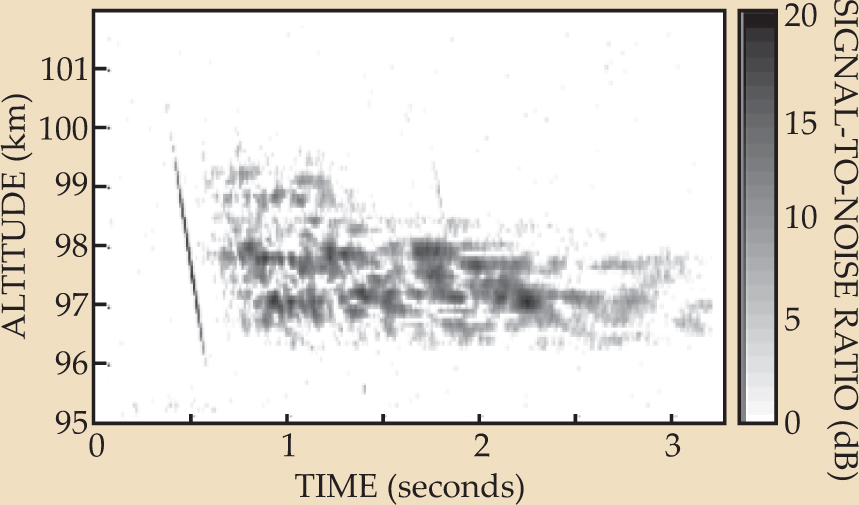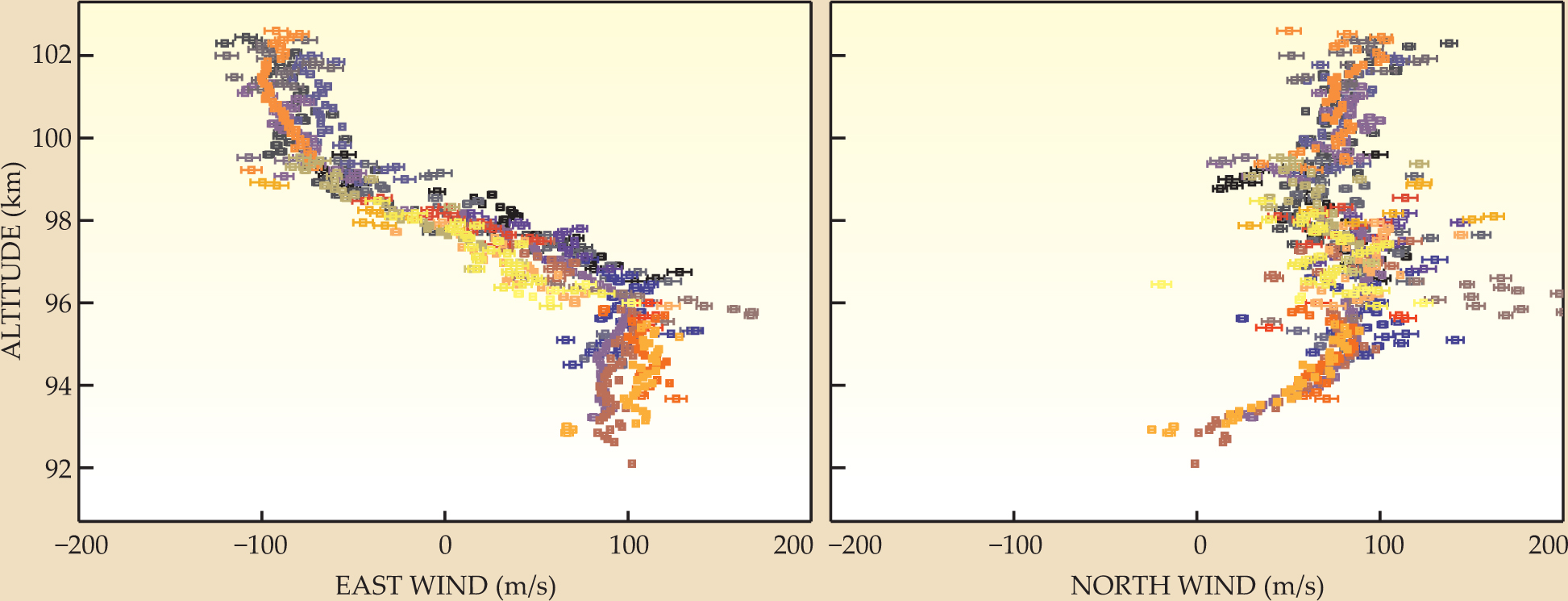Meteor trails track upper atmospheric winds
DOI: 10.1063/1.3156320
At an altitude of 100 km, the density of air is less than a millionth of that on Earth’s surface—thin enough that the mean free path of each molecule is on the scale of a meter. The density of ions and electrons is a million times smaller still. Those rarefied conditions make the lower reaches of Earth’s thermosphere, between 85 km and 110 km, a no man’s land, inaccessible to the highest research balloons and the lowest orbiting satellites and difficult to probe with radars.
Yet that layer of the atmosphere is transformative. It buffers lower layers against solar x rays and UV; it marks the transition from diffusive interactions above 100 km to turbulent mixing below it; and it is substantial enough to vaporize billions of meteors—most smaller than a grain of sand—that intersect Earth’s orbit every day.
Every year, kilotons of material ablated from those meteors coagulate into dust that can seed clouds lower down in the troposphere or otherwise influence atmospheric chemistry. Meteoric dust and ions are small enough to be blown about easily in the thin air of the thermosphere. The driving force comes from tidal oscillations—periodic fluctuations in density, pressure, and temperature lower down—and gravity waves (also known as buoyancy waves), which arise from vertical oscillations in stratified air as it flows over mountains, islands, or other topographic features. When the waves rise and break, they transfer energy and momentum to the upper atmosphere (see John Emmert’s Quick Study in Physics Today, December 2008, page 70
Indeed, winds throughout the thermosphere blow at hurricane speeds, up to 150 m/s. And differences in velocity of nearly that magnitude (around 100 m/s) between layers of air separated vertically by just a few kilometers create enormous wind shears. Those values are typical of what’s been found from some 400 rocket-based experiments over the past half century. The rockets release luminescent tracers into the thermosphere for ground cameras to track as the tracers drift in the wind. 1
Climate-circulation models fail to predict the wild swings in velocity from one altitude to another and the amount of momentum carried to the upper atmosphere. Moreover, the rocket experiments are expensive and the data anecdotal: Each launch costs $1 million to probe one wind profile for just a few minutes.
Meers Oppenheim and his colleagues from Boston University, Peru’s Jicamarca Radio Observatory (JRO), and Los Alamos National Laboratory now offer an alternative approach 2 that has its origins in another 50-year-old technique. Free electrons produced in the plasma trails of incoming meteors make an ideal radar target. They also work well as wind tracers: The plasma preserves its charge neutrality such that the highly mobile electrons remain closely tied to heavy ions that are swept along in the neutral wind. For decades aeronomers have inferred wind speed based on the average Doppler shift they record from specular echoes, reflections from the trails when their paths lie normal to the radar beam. But those echoes give just one velocity component at one height at one time from each meteor. The averaging required to combine many meteor signals into a wind profile washes out the fine structure.
Larger radar, richer data
Fortunately, very sensitive radar or large enough meteors can free one from reliance on specular echoes. In either case, reflections from any angle that satisfies the Bragg condition will do. Four years ago, and again in 2007, Oppenheim and colleagues gained access to JRO. There, three 1.5-MW transmitters and an array of nearly 19 000 dipole antennas were trained on a narrow part of the sky. The combination is powerful enough to detect the non-specular signals backscattered all along an ionization trail, including the rich heterogeneous structure that Oppenheim’s earlier numerical simulations had predicted should emerge as the plasma disperses. 3 , 4
Figure 1 captures the first few seconds in the evolution of a single trail detected 12 July 2005. The thin streak is the front edge of the plasma created during the few hundred milliseconds the meteor takes to plow through the lower thermosphere. Behind the ionization front, hot gas and electrons flow too smoothly for radio waves to coherently reflect changes in the dielectric constant, so the signal vanishes. But plasma instabilities driven by the density gradient and by complex electric fields set up between magnetized electrons and collisionally demagnetized ions quickly give rise to turbulence and irregular clumps of plasma that align along Earth’s magnetic field.

Figure 1. Collisions of a tiny meteor with thermospheric air leave a trail of electrons and ions whose evolution in space and time can be measured. Jicamarca Radio Observatory’s large radar array at Earth’s geomagnetic equator recorded 5000 reflections per second for each altitude bin. The thin streak represents the “head echo,” the leading edge of the ionization front. Once it starts flowing, an initially smooth column of hot plasma (invisible to radar) becomes turbulent as instabilities in the plasma give rise to irregular clumps that align with the magnetic field. Note the appearance of a second, faint head echo 1.5 seconds after the first when another meteor flies through the beam.
(Adapted from

Peru’s JRO sits directly on the geomagnetic equator. Its radar points nearly perpendicular to the field lines, so the scattering cross section is optimal for detecting that blobby aftermath. Also important for observations, JRO’s antennas can be partitioned into a phased array capable of interferometry. By beating the phase of one radar channel against another, the team measured not just the position of each part of a plasma trail over time but also its bearing. To get the velocities, they fit the slope of the phase differences between the channels as a function of time.
The interferometry measurements allowed the researchers to build a complete vector profile of the horizontal wind speeds at different altitudes with a spatial resolution less than a few hundred meters—comparable to that from rocket tracer experiments. The profile can also be derived repeatedly on a nearly continuous basis. During the hours before dawn when Earth runs headlong into meteors, JRO detects one every half second or so. Figure 2 shows the proof-of-principle plots of wind vectors constructed from data of many meteors intercepted over several minutes one night in 2005.

Figure 2. Wind-velocity profiles, compiled from the data of many meteors (each represented by a different color) whose plasma trails intersect the radar beam within minutes of each other. Using interferometry to keep track of the phase difference between different channels in the radar array, one can follow the position and bearing of each part of a meteor’s trail over several seconds as it’s swept up in the winds. The signals from some larger meteors can persist beyond 20 seconds.
(Adapted from

Remarkably, Oppenheim’s team waited nearly four years before analyzing its interferometry data. “Plasma instabilities were on my mind, not winds,” Oppenheim confesses. “I never guessed that the changes in phase from what is mostly turbulence would be as clean as they turned out to be.”
References
1. M. F. Larsen, J. Geophys. Res. 107, 1215 (2002), https://doi.org/10.1029/2001JA000218
.2. M. M. Oppenheim, G. Sugar, N. O. Slowey, E. Bass, J. L. Chau, S. Close, Geophys. Res. Lett. 36, L09817 (2009), https://doi.org/10.1029/2009GL037353
.3. M. M. Oppenheim, L. P. Dyrud, A. F. vom Endt, J. Geophys. Res. 108, 1064 (2003), https://doi.org/10.1029/2002JA009549
.4. M. M. Oppenheim, G. Sugar, E. Bass, Y. S. Dimant, J. Chau, Geophys. Res. Lett. 35, L03102 (2008), https://doi.org/10.1029/2007GL032347
.
